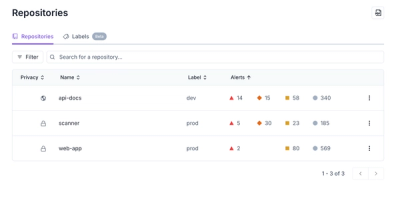
Product
Redesigned Repositories Page: A Faster Way to Prioritize Security Risk
Our redesigned Repositories page adds alert severity, filtering, and tabs for faster triage and clearer insights across all your projects.
@ledgerhq/wallet-api-simulator
Advanced tools
Test and develop your application or service without Ledger Live
Full documentation · Report Bug · Request Feature
The Ledger Wallet Simulator is a comprehensive tool designed to emulate the behavior of a Ledger device simulating responses and interactions with the wallet-API. It aids developers in testing and interacting with Ledger-related applications without requiring a physical Ledger device or necessitating the run of your application inside the WebView of the LedgerLive software. This documentation will guide you through the process of setting up and using the simulator.
By following this documentation, you'll be equipped to install, set up, and make the most out of this simulator. If any issues arise or further customization is needed, consider diving deeper into the source code or consulting the official documentation.
To install the Ledger Wallet Simulator, you'll first need to include the necessary dependencies in your project.
npm install @ledgerhq/wallet-api-client
Then, install the simulator package:
npm install @ledgerHQ/simulator
Begin by setting up the transport using the getSimulatorTransport function.
import { getSimulatorTransport, profiles } from "@ledgerHQ/simulator";
const transport = getSimulatorTransport(profiles.STANDARD);
transport.onMessage = handleMessageFunction; // Replace with your message handler.
Create a createClient function that return a new client. The provided simulated transport should be passed to the WalletAPIClient() as a parameter to effectively interact with the WalletAPIClient. Normally, WalletAPIClient only works with real transport, but the simulator provides a simulated transport for this purpose.
Here's a basic form:
function createClient() {
// insert the transport created above
return new WalletAPIClient(transport);
}
The simulator comes with predefined profiles (STANDARD and DEVICE), which determine the behavior and data of the simulator. You can easily extend these profiles by spreading inside the profile object:
const extendedProfile = {
...profiles.STANDARD,
yourInfo: "yourValue", // Add any custom information here.
};
The primary use case for the simulator is to emulate a Ledger device's behavior for development and testing purposes. Here's a basic example:
// Create a client
const client = createClient();
// List accounts
const response = await client.transaction.list();
console.log(response);
FAQs
WalletAPI Simulator Test and develop your applic
The npm package @ledgerhq/wallet-api-simulator receives a total of 2,790 weekly downloads. As such, @ledgerhq/wallet-api-simulator popularity was classified as popular.
We found that @ledgerhq/wallet-api-simulator demonstrated a healthy version release cadence and project activity because the last version was released less than a year ago. It has 8 open source maintainers collaborating on the project.
Did you know?

Socket for GitHub automatically highlights issues in each pull request and monitors the health of all your open source dependencies. Discover the contents of your packages and block harmful activity before you install or update your dependencies.

Product
Our redesigned Repositories page adds alert severity, filtering, and tabs for faster triage and clearer insights across all your projects.

Security News
Slopsquatting is a new supply chain threat where AI-assisted code generators recommend hallucinated packages that attackers register and weaponize.

Security News
Multiple deserialization flaws in PyTorch Lightning could allow remote code execution when loading untrusted model files, affecting versions up to 2.4.0.